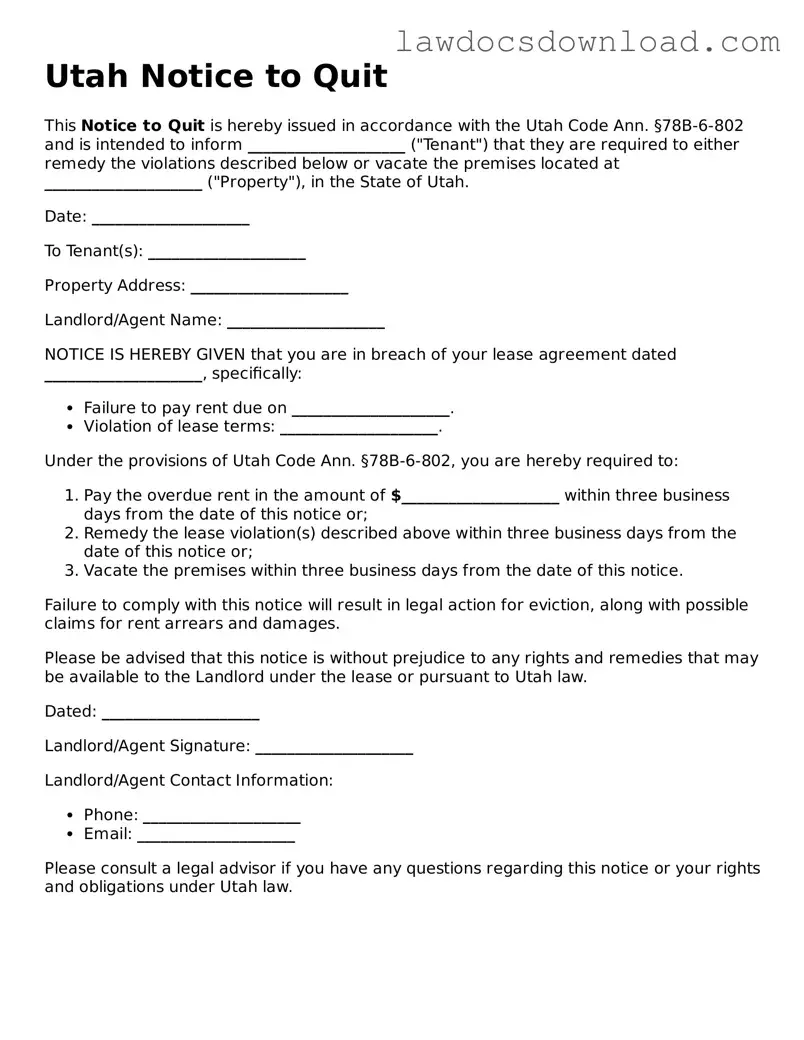A Notice to Vacate serves a similar purpose to the Utah Notice to Quit, as it informs tenants that they must leave the property by a certain date. This document is often used by landlords to begin the process of ending a tenancy. While the Notice to Vacate can be given for various reasons, including the end of a lease term or breach of lease conditions, alike the Notice to Quit, it essentially communicates the same message: the landlord wishes to reclaim possession of the property.
An Eviction Notice, much like the Utah Notice to Quit, is a formal document a landlord sends to a tenant to notify them of a lease violation or the termination of their rental agreement. Both documents are critical steps in the legal process of eviction. However, an Eviction Notice may include specific legal grounds for eviction and possibly offer the tenant a chance to rectify the situation, depending on state laws.
The Lease Termination Letter shares similarities with the Utah Notice to Quit in that it formally communicates the discontinuation of a lease agreement between the landlord and tenant. This letter can be initiated by either party for reasons such as the end of the lease period, a mutual agreement to part ways, or breach of lease terms. Unlike the more immediate implications of a Notice to Quit due to misconduct or nonpayment of rent, a Lease Termination Letter typically allows for a 30-to-60-day notice period for vacating the property.
A Rent Increase Notice, while fundamentally different in purpose from a Utah Notice to Quit, shares the similarity of notifying tenants of changes to the terms of their lease agreement. This document informs tenants of an upcoming rent increase and becomes relevant when landlords intend to modify the lease agreement's financial terms. Unlike a Notice to Quit, which signals an end to the tenancy, a Rent Increase Notice adjusts the ongoing terms, maintaining the landlord-tenant relationship.
The Cure or Quit Notice is closely related to the Utah Notice to Quit but specifically allows the tenant an opportunity to "cure," or fix, the violation described in the notice within a specified timeframe. This could include actions such as paying overdue rent or ceasing disruptive behavior. If the tenant fails to comply, they are then required to "quit," or leave, the property. This gives tenants a chance to rectify their mistakes and maintain their tenancy, which isn't always an option with a straightforward Notice to Quit.
A Pay or Quit Notice, similar to the Utah Notice to Quit, is used by landlords to address the issue of unpaid rent. It instructs the tenant to either pay the outstanding rent by a certain date or vacate the property. This document serves as a warning that further legal action may ensue if the tenant neither pays the rent nor leaves the property, elevating it to a step before potential eviction proceedings, akin to the function of a Notice to Quit.
A 30-Day Notice to Vacate operates in a similar vein to the Utah Notice to Quit, primarily utilized to inform tenants that they need to vacate the property within 30 days. Commonly used for month-to-month tenancies or as a way to end a longer lease with advance notice, it provides a clear deadline for departure, much like the Notice to Quit's purpose of reclaiming the property. However, it is more flexible and is often employed in less confrontational circumstances.
Finally, a Lease Violation Notice parallels the Utah Notice to Quit by alerting tenants that they have violated a specific term or condition of their lease agreement. This notice details the nature of the violation and, depending on the terms of the lease and local laws, may offer the tenant a chance to correct the issue before further action is taken. It is a precursor to more severe measures, such as eviction, offering a clear path to resolution if possible.
